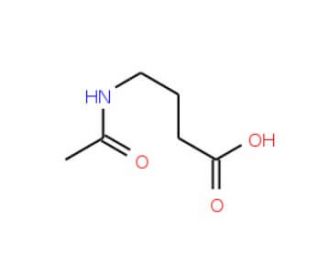

Molecular structure of 4-Acetamidobutyric acid, CAS Number: 3025-96-5
4-Acetamidobutyric acid (CAS 3025-96-5)
See product citations (1)
CAS Number:
3025-96-5
Purity:
≥95%
Molecular Weight:
145.16
Molecular Formula:
C6H11NO3
For Research Use Only. Not Intended for Diagnostic or Therapeutic Use.
* Refer to Certificate of Analysis for lot specific data.
QUICK LINKS
Ordering Information
Product Citations
Description
Technical Information
Safety Information
SDS & Certificate of Analysis
4-Acetamidobutyric acid, also known as 4-ABA, is a small molecule widely used in studies of various biological processes, including enzyme activities, signal transduction pathways, and cell-cell interactions. For example, it has been employed to study the binding of various proteins to DNA, to investigate the mechanisms of action of many proteins, and to study the effects of several compounds on cell proliferation. 4-Acetamidobutyric acid acts as an inhibitor of certain enzymes and proteins, as well as an agonist of certain receptors. It may act to increase the activity of phosphatases, kinases, G-protein coupled receptors, and ion channels.
4-Acetamidobutyric acid (CAS 3025-96-5) References
- Characterization of a protein-bound polysaccharide from Herba Epimedii and its metabolic mechanism in chronic fatigue syndrome. | Chi, A., et al. 2017. J Ethnopharmacol. 203: 241-251. PMID: 28359851
- Phthalate exposure and childhood overweight and obesity: Urinary metabolomic evidence. | Xia, B., et al. 2018. Environ Int. 121: 159-168. PMID: 30208345
- Therapeutic Effect and Metabolic Mechanism of A Selenium-Polysaccharide from Ziyang Green Tea on Chronic Fatigue Syndrome. | Shao, C., et al. 2018. Polymers (Basel). 10: PMID: 30961194
- Metabolomics Combined with Transcriptomics Analysis Revealed the Amino Acids, Phenolic Acids, and Flavonol Derivatives Biosynthesis Network in Developing Rosa roxburghii Fruit. | Li, N., et al. 2022. Foods. 11: PMID: 35681389
- Highly Selective Purification of Plasma Extracellular Vesicles Using Titanium Dioxide Microparticles for Depicting the Metabolic Signatures of Diabetic Retinopathy. | Pan, Y., et al. 2022. Anal Chem. 94: 14099-14108. PMID: 36197877
- Plasma metabolomics provides new insights into the relationship between metabolites and outcomes and left ventricular remodeling of coronary artery disease. | Zhu, Q., et al. 2022. Cell Biosci. 12: 173. PMID: 36242008
- Extracellular vesicles metabolic changes reveals plasma signature in stage-dependent diabetic kidney disease. | Pan, Y., et al. 2022. Ren Fail. 44: 1840-1849. PMID: 36368309
- Variations in gut microbiome and metabolites of dogs with acute diarrhea in poodles and Labrador retrievers. | Bai, H., et al. 2023. Arch Microbiol. 205: 97. PMID: 36823480
- Long-term simulated microgravity alters gut microbiota and metabolome in mice. | Yuan, L., et al. 2023. Front Microbiol. 14: 1100747. PMID: 37032862
- Helix-coil transition of Poly(L-glutamic acid) in N-methylacetamide. | Harry, JB. and Franzen, JS. 1969. Biopolymers. 8: 433-48. PMID: 5358943
- Discovery of biomarkers for depressed patients and evaluation of Xiaoyaosan efficacy based on liquid chromatography-mass spectrometry | Linghu, T., Liu, C., Wang, Q., Tian, J., & Qin, X. 2021. Journal of Liquid Chromatography & Related Technologies. 44(11-12): 538-549.
- Transcriptomics and metabolomics analyses provide insights into postharvest ripening and senescence of tomato fruit under low temperature | Bai, C., Wu, C., Ma, L., Fu, A., Zheng, Y., Han, J.,.. & Zuo, J. 2023. Horticultural Plant Journal. 9(1): 109-121.
- UHPLC-QTOF-MS-based untargeted metabolomics revealing the differential chemical constituents and its application on the geographical origins traceability of lily bulbs | Long, W., Wang, S., Hai, C., Chen, H., Gu, H. W., Yin, X. L.,.. & Fu, H. 2023. Journal of Food Composition and Analysis. 118: 105194.
Ordering Information
| Product Name | Catalog # | UNIT | Price | Qty | FAVORITES | |
4-Acetamidobutyric acid, 10 g | sc-276980 | 10 g | $184.00 |
